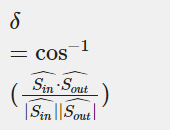Consider:
I found this formula in https://doi.org/10.1364/BOE.426653 (NLM), a paper titled: Stokes polarization imaging applied for monitoring dynamic tissue optical clearing.
The formula is for calculating the linear retardance of a sample image using a Stokes polarization camera and a right circular polarizing filter over a source light. I already have several other parameters calculated for a camera I'm making and this seems like an interesting one to include.
Unfortunately, I'm not familiar with the notation the researchers used to write the formula. My best guess is the normalized vectors multiplied together for in and out divided by the absolute value of the normalized vectors. But that doesn't make any sense because normalized vectors are already positive.

